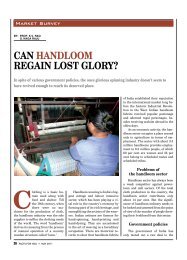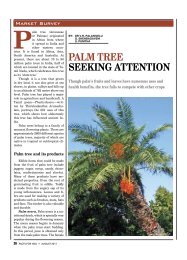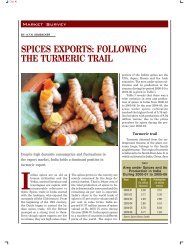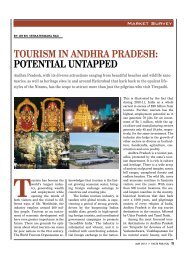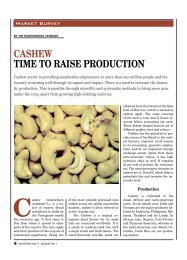DaIry farmIng the rural cash cow - Facts For You
DaIry farmIng the rural cash cow - Facts For You
DaIry farmIng the rural cash cow - Facts For You
Create successful ePaper yourself
Turn your PDF publications into a flip-book with our unique Google optimized e-Paper software.
Market Survey<br />
By: Dr P. Chennakrishnan<br />
Dairy farming<br />
<strong>the</strong> <strong>rural</strong> <strong>cash</strong> <strong>cow</strong><br />
Dairy farming has <strong>the</strong> prospects to offer quality lifestyle to <strong>rural</strong> India. Proper investment<br />
structure and strategies are required in this sector to turn it into an organised and<br />
profitable business.<br />
Dairy industry is of<br />
crucial importance to<br />
India. The country accounts<br />
for more than 15<br />
per cent of world’s total<br />
milk production. It is <strong>the</strong> world’s<br />
largest consumer of dairy products,<br />
consuming almost 100 per cent of its<br />
own milk production. Dairy products<br />
are a major source of cheap and nutritious<br />
food to millions of people in<br />
India and <strong>the</strong> only acceptable source<br />
of animal protein for large vegetarian<br />
segment of Indian population,<br />
particularly <strong>the</strong> landless, small and<br />
marginal farmers and women.<br />
Dairy development programmes<br />
play a vital role in <strong>the</strong> socio-economic<br />
conditions of <strong>the</strong> <strong>rural</strong> people. Higher<br />
demand for milk means adding larger<br />
number of high-breed milk producing<br />
cattle to <strong>the</strong> milch population. A<br />
large part of this cattle population<br />
is owned and reared in <strong>rural</strong> areas.<br />
Thus, small/marginal farmers and<br />
landless agricultural labourers play a<br />
very important role in milk production<br />
of <strong>the</strong> country. Dairy farming can<br />
also be taken up as a main occupation<br />
around big urban centres where <strong>the</strong><br />
demand for milk is high.<br />
The cooperative movement for<br />
milk was started in India in <strong>the</strong> last<br />
decade of <strong>the</strong> nineteenth century<br />
with two objectives in view—protecting<br />
<strong>the</strong> farmers from <strong>the</strong> hands<br />
of <strong>the</strong> private money lenders and<br />
improving <strong>the</strong>ir economic condition.<br />
Madras province was <strong>the</strong> birthplace<br />
of this movement. With <strong>the</strong> setting<br />
up of agricultural cooperative banks<br />
<strong>the</strong>re, <strong>the</strong> movement took root and<br />
slowly gained strength.<br />
However, <strong>the</strong> growth of cooperative<br />
movement in India during<br />
British rule was very slow and haphazard<br />
one. In most of <strong>the</strong> cases,<br />
<strong>the</strong> provincial governments took<br />
<strong>the</strong> lead. The foreign ruler had only<br />
made some committees or framed a<br />
few rules and regulations. But <strong>the</strong>y<br />
did not take up any wide-ranging<br />
programme to spread <strong>the</strong> movement<br />
all over <strong>the</strong> country.<br />
The history of dairy development<br />
movement in India is a new one.<br />
During <strong>the</strong> pre-independence period<br />
10 FACTS FOR YOU • November 2011
this movement was limited to a few<br />
pockets of Calcutta, Madras, Bengaluru<br />
and Gujarat. The most notable<br />
of this venture was Kaira District<br />
Cooperative Milk Producers’ Union<br />
of Anand, Gujarat.<br />
After independence <strong>the</strong> government<br />
took great initiative in setting<br />
up new dairy cooperatives in many<br />
parts of <strong>the</strong> country. The golden<br />
era of cooperative movement began<br />
after India’s independence. Within<br />
two decades of independence <strong>the</strong><br />
membership of primary societies increased<br />
four times while <strong>the</strong> share<br />
capital and working capital increased<br />
23 and 31 times, respectively.<br />
The National Dairy and Development<br />
Board (NDDB) was founded in<br />
1965, with <strong>the</strong> mission of organising<br />
poor milk producers, <strong>the</strong>reby transforming<br />
dairying into an instrument<br />
for <strong>the</strong> economic development of India’s<br />
<strong>rural</strong> people. The formation of<br />
<strong>the</strong> NDDB stemmed from <strong>the</strong> vision<br />
of <strong>the</strong> <strong>the</strong>n prime minister of India,<br />
Lal Bahadur Shastri, to extend <strong>the</strong><br />
success of <strong>the</strong> Kaira Cooperative<br />
Milk Producer’s Union (in <strong>the</strong> state<br />
of Amul) to o<strong>the</strong>r parts of India.<br />
NDDB was set up to make <strong>the</strong> ambitious<br />
project a success.<br />
However, organising illiterate<br />
farmers into a large cooperative network<br />
proved to be a challenging task.<br />
O<strong>the</strong>r major issues were <strong>the</strong> quality<br />
and <strong>the</strong> hygiene maintenance of<br />
<strong>the</strong> milk being distributed; taking<br />
into account <strong>the</strong> combined effect of<br />
milk’s perishability and <strong>the</strong> fact that<br />
milk was supplied by a large number<br />
of small milk producers.<br />
Dairy farming<br />
Dairy farming is a major livelihood<br />
followed by many households<br />
in <strong>rural</strong> areas. This includes rearing<br />
milk cattle—<strong>cow</strong>s, buffaloes, goats<br />
and sheep. There is a shortage of<br />
milk in <strong>the</strong> country as consumption<br />
in both urban and <strong>rural</strong> areas has<br />
risen sharply.<br />
Table I<br />
Milch Animals Population<br />
in India<br />
(million)<br />
Year Cows Buffaloes<br />
1951 46.37 21.01<br />
1961 51.01 24.24<br />
1971 53.41 28.61<br />
1981 55.40 33.07<br />
1991 57.32 38.65<br />
1997 64.42 38.65<br />
2003 64.51 50.97<br />
2007 73 54.5<br />
Source: Department of Animal Husbandry, Dairying<br />
Market Survey<br />
Dairying has been considered<br />
as one of <strong>the</strong> activities aimed at alleviating<br />
<strong>the</strong> poverty and unemployment,<br />
especially in <strong>the</strong> <strong>rural</strong> areas,<br />
rain-fed and drought-prone regions.<br />
In India, about three-fourth of <strong>the</strong><br />
population lives in <strong>rural</strong> areas and<br />
about 38 per cent of <strong>the</strong>m are poor.<br />
Dairying is an important source of<br />
subsidiary income to small/marginal<br />
farmers and agricultural labourers.<br />
They play a very important role in<br />
milk production of <strong>the</strong> country. In<br />
1986-87, about 73 per cent of <strong>rural</strong><br />
households owned livestock. Small<br />
and marginal farmers accounted for<br />
three-quarters of <strong>the</strong>se households<br />
owning livestock, raising 56 per cent<br />
of <strong>the</strong> bovine and 66 per cent of <strong>the</strong><br />
sheep population.<br />
According to <strong>the</strong> National Sample<br />
Survey of 1993-94, livestock sector<br />
produces regular employment to<br />
about 9.8 million persons in principal<br />
status and 8.6 million in subsidiary<br />
status, which constitute about 5<br />
per cent of <strong>the</strong> total work force. The<br />
progress in this sector will result in<br />
a more balanced development of <strong>the</strong><br />
<strong>rural</strong> economy.<br />
The manure from animals provides<br />
a good source of organic matter<br />
for improving soil fertility and<br />
crop yields. The gober gas from <strong>the</strong><br />
dung is used as fuel for domestic<br />
purposes and also for running engines<br />
for drawing water from wells.<br />
The surplus fodder and agricultural<br />
by-products are gainfully utilised<br />
for feeding <strong>the</strong> animals. Since agriculture<br />
is mostly seasonal, <strong>the</strong>re is<br />
a possibility of finding employment<br />
throughout <strong>the</strong> year for many persons<br />
through dairy farming. Thus,<br />
dairy also provides employment<br />
throughout <strong>the</strong> year.<br />
Milk processing<br />
The milk processing industry is<br />
small compared to <strong>the</strong> huge amount<br />
of milk produced every year. Only 10<br />
per cent of all <strong>the</strong> milk is delivered<br />
to some 400 dairy plants. A specific<br />
Indian phenomenon is <strong>the</strong> unorganised<br />
sector of milkmen and vendors,<br />
which handles around 65-70 per<br />
cent of <strong>the</strong> national milk production.<br />
They collect milk from local producers<br />
and sell it in both urban and nonurban<br />
areas.<br />
In <strong>the</strong> organised dairy industry,<br />
<strong>the</strong> cooperative milk processors have<br />
a 60 per cent market share. Cooperative<br />
dairies process 90 per cent<br />
of <strong>the</strong> collected milk as liquid milk,<br />
whereas private dairies process and<br />
sell only 20 per cent of <strong>the</strong> milk collected<br />
as liquid milk and 80 per cent<br />
for o<strong>the</strong>r dairy products with a focus<br />
on value-added products.<br />
Domestic consumption<br />
The huge volume of milk produced<br />
in India is consumed almost<br />
entirely by <strong>the</strong> Indian population itself<br />
in a 50-50 division between urban<br />
and no-urban areas. Increasingly, important<br />
consumers of <strong>the</strong> dairy industry<br />
are fast-food chains and food and<br />
non-food industries using dairy ingredients<br />
in a wide range of products.<br />
National importance of<br />
dairy farming<br />
More than 15 per cent of <strong>the</strong> total<br />
world production of milk is con-<br />
November 2011 • FACTS FOR YOU 11
Market Survey<br />
Table II<br />
Milk Production and Per Capita<br />
Availability<br />
Year Per capita availability Production<br />
(gram/day)<br />
(million tonnes)<br />
1950-51 132 17.00<br />
1960-61 127 20.00<br />
1970-71 112 22.00<br />
1980-81 131 31.06<br />
1990-91 176 53.09<br />
2000-01 220 80.06<br />
2005-06 241 97.01<br />
2006-07 246 100.09<br />
2007-08 252 104.08<br />
2008-09 258 108.05<br />
2009-10 263 112.05<br />
2010-11* — 116.2<br />
*Projection<br />
Source: Department of Animal Husbandry, Dairying & Fisheries,<br />
Ministry of Agriculture<br />
tributed by India. The large Indian<br />
vegetarian sector feeds upon <strong>the</strong><br />
dairy products of India. This part<br />
of <strong>the</strong> industry has also helped <strong>the</strong><br />
economy in many ways. The sector<br />
has addressed some of <strong>the</strong> glaring<br />
problems of unemployment and <strong>the</strong><br />
rates of poverty. The industry has<br />
seen rapid growth in recent years.<br />
The best possible technologies are<br />
undertaken and resources are used<br />
to <strong>the</strong> fullest extent so that <strong>the</strong> sector<br />
reaches <strong>the</strong> booming phase. India<br />
houses <strong>the</strong> largest livestock in <strong>the</strong><br />
world. Milk and milk products of India<br />
are highly acclaimed in different<br />
parts of <strong>the</strong> world.<br />
Some of <strong>the</strong> past reports found<br />
that when <strong>the</strong> production of milk<br />
was 72 million, its demand reached<br />
80 million. So <strong>the</strong> country under<br />
<strong>the</strong> regulatory bodies have gone far<br />
to increase <strong>the</strong> production of milk<br />
and o<strong>the</strong>r milk products to higher<br />
extent.<br />
With high milk production, <strong>the</strong><br />
scope of milk processing industry<br />
has also increased. This is fur<strong>the</strong>r<br />
pushed as <strong>the</strong> purchasing power<br />
of <strong>the</strong> consumer has increased and<br />
transport facilities are<br />
much readily available.<br />
Apart from <strong>the</strong> cooperative<br />
and public milk sectors<br />
<strong>the</strong>re are certain upcoming<br />
private sectors,<br />
which require trained and<br />
wide recourse of manpower.<br />
This natural resource<br />
gives scope for fur<strong>the</strong>r<br />
widening with <strong>the</strong> production<br />
of o<strong>the</strong>r value-added<br />
products like condensed<br />
milk, cheese, khoa and<br />
baby foods. The chocolate<br />
and ice-cream industry<br />
can also enhance exports<br />
with its increasing production.<br />
The country should<br />
focus on exporting quality<br />
goods to meet <strong>the</strong> level of<br />
international market.<br />
Production and scope of<br />
dairy farming<br />
The total milk production in<br />
<strong>the</strong> country reached 100.09 million<br />
tonnes at <strong>the</strong> end of <strong>the</strong> tenth fiveyear<br />
plan (2006-07) as compared to<br />
53.90 million tonnes in 1990-91. The<br />
per capita availability of milk has<br />
increased from 233 grams per day<br />
in 2004-05 to 263 grams per day in<br />
2009-10. The share of milk production<br />
in 2009-10 by exotic/cross-bred<br />
<strong>cow</strong>s, indigenous/non-descript <strong>cow</strong>s,<br />
buffaloes and goats was 25.3 million<br />
tonnes, 22.5 million tonnes,<br />
59.2 million tonnes and 3.9 million<br />
tonnes, respectively.<br />
Table II shows <strong>the</strong> production of<br />
milk from 1950-51 to 2010-11. Milk<br />
production in 2009-10 was 112.05<br />
million tonnes, which followed a<br />
growth rate of 4 per cent. The country<br />
is stressing on <strong>the</strong> milk product<br />
industries to increase <strong>the</strong>ir production<br />
rate. All <strong>the</strong> public and <strong>the</strong> private<br />
sectors of milk production are<br />
taken into grant.<br />
The projected estimate of milk<br />
production for 2010-11 was 116.2<br />
million tones The projected rate of<br />
production of milk in 2020 is around<br />
240 million tonnes. If <strong>the</strong>se figures<br />
are achieved <strong>the</strong>n India would be<br />
able to contribute 30-35 per cent to<br />
<strong>the</strong> world’s milk production.<br />
Annual milk production in India<br />
has grown more than six times<br />
since independence. The average<br />
annual growth rate in <strong>the</strong> production<br />
of milk in recent years has been<br />
close to 4 per cent. Even though <strong>the</strong><br />
level of per capita availability at 263<br />
grams per day for India in 2009-10 is<br />
much lower than that in developed<br />
countries, it is well above <strong>the</strong> developing<br />
country average. The eleventh<br />
five-year plan envisages an overall<br />
growth of 6-7 per cent per annum<br />
for this sector.<br />
As per an assessment made by<br />
<strong>the</strong> Planning Commission, <strong>the</strong> domestic<br />
demand for milk by 2021-<br />
22 is expected to be 172.20 million<br />
tonnes. This is due to higher consumption<br />
rate. As projected under<br />
<strong>the</strong> proposed National Dairy Plan,<br />
<strong>the</strong> production of milk in <strong>the</strong> country<br />
is required to increase to 180<br />
million tonnes by 2021-22 to meet<br />
<strong>the</strong> demand. However, <strong>the</strong> country<br />
has not been able to keep pace with<br />
<strong>the</strong> domestic demand for milk. The<br />
domestic demand for milk is growing<br />
at about 6 million tonnes per<br />
year, whereas annual incremental<br />
Table III<br />
Value of Output from<br />
Milk Group<br />
(at current prices in Rs billion)<br />
Year<br />
Value<br />
2004-05 1239.07<br />
2005-06 1328.12<br />
2006-07 1449.99<br />
2007-08 1652.54<br />
2008-09 1856.85<br />
2009-10 2288.09<br />
Source: National Accounts Statistics 2011; Central<br />
Statistical Organisation, government of India<br />
12 FACTS FOR YOU • November 2011
Market Survey<br />
production over <strong>the</strong> last ten years<br />
has been about 3.5 million tonnes<br />
per year.<br />
Matters of concern<br />
With higher growth of <strong>the</strong> economy,<br />
increase in population and<br />
increased health consciousness,<br />
it is only natural that <strong>the</strong> demand<br />
for milk and milk products will increase<br />
leading to an increase in<br />
<strong>the</strong> proportion of income spent on<br />
milk and milk products. Fur<strong>the</strong>r,<br />
<strong>the</strong> demand for processed and packaged<br />
dairy products will increase in<br />
<strong>the</strong> urban centres. However, in <strong>rural</strong><br />
areas people may still prefer to<br />
purchase from <strong>the</strong> local milkmen.<br />
About 80 per cent of milk produced<br />
in <strong>the</strong> country is still handled in <strong>the</strong><br />
unorganised sector and only <strong>the</strong><br />
remaining 20 per cent is equally<br />
shared by cooperatives and private<br />
dairies.<br />
Despite <strong>the</strong> growth in milk production<br />
in <strong>the</strong> last six<br />
decades, <strong>the</strong> productivity<br />
of <strong>the</strong> animals is<br />
still low. The marketing<br />
systems are also<br />
not modernised or<br />
developed to a satisfactory<br />
level. O<strong>the</strong>r issues<br />
in this sector are<br />
ineffective breeding<br />
programmes, limited<br />
availability and affordability<br />
of quality feed<br />
and fodder, improper<br />
veterinary infrastructure,<br />
lack of vaccinations,<br />
inadequate access<br />
to formal credit<br />
mechanisms, inadequate<br />
research capacity<br />
and limited processing<br />
capacity.<br />
Considering that<br />
<strong>the</strong> requirement of<br />
milk in 2021-22 is expected<br />
to be 180 million<br />
tonnes and <strong>the</strong><br />
current level of milk production is<br />
112 million tonnes, <strong>the</strong> milk production<br />
must increase at around 5.5 per<br />
cent per annum in <strong>the</strong> next 12 years.<br />
If it fails to do so, India may need<br />
to resort to imports from <strong>the</strong> world<br />
market. A large consumer like India<br />
entering <strong>the</strong> international market<br />
would have <strong>the</strong> potential to cause international<br />
prices to spurt. Hence it<br />
is prudent to depend on <strong>the</strong> domestic<br />
market and develop <strong>the</strong> milk sector<br />
with <strong>the</strong> right attention and focus<br />
and <strong>the</strong> required investment.<br />
Recent hikes in prices of milk and<br />
milk products have been a matter of<br />
concern. The gap between domestic<br />
demand and production of milk has<br />
put upward pressure on milk prices.<br />
Only a strong supply response with<br />
focus on production and productivity<br />
can keep <strong>the</strong> prices stable.<br />
•<br />
The author is assistant professor in department<br />
of economics at Thiruvalluvar<br />
University, Vellore<br />
November 2011 • FACTS FOR YOU 13



